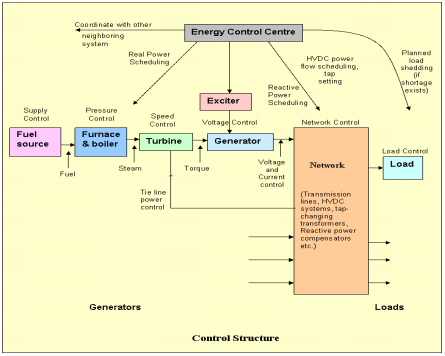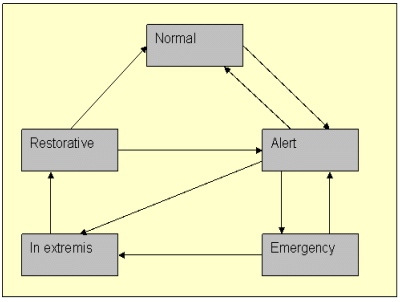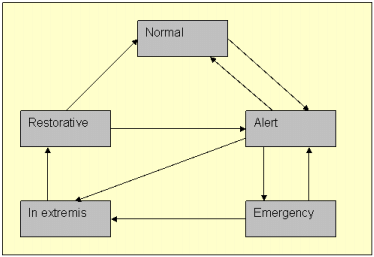Operating States
Operational Objectives
Before we discuss issues in control of a power system, it is important to understand the objectives.
The operational objectives of a power system are:
→ Continual matching of load demand (plug and play!): Electrical energy cannot be conveniently stored in sufficient quantities. Therefore a readily available reserve of generation should be available and controlled. However in many developing countries, there are shortages of generation resulting in load curtailment.
→ The power system should provide for a certain level of reliability and quality (frequency and magnitude of voltages should lie in a narrow, pre-defined range).
→ The electrical energy should be at low cost and have a low environmental impact.
Hierarchy of controls in a power system
Does a power system require continuous monitoring and control?
Yes. Like many other engineering systems, a power system operator has to continuously monitor the health of a power system and perform control actions when necessary. A power system has a large number of automatic controllers too. Manual actions may be necessary to supplement these controllers. In fact, there is a well defined hierarchy of controls which are deployed.
Equipments like generators have a wide array of automatic feedback control systems which not only serve to implement real and reactive power scheduling commands, but also regulate key parameters like voltage & frequency, prevent thermal overloads, over-speed etc. Most of the controllers are decentralised, i.e., they use locally available feedback and control a locally accessible quantity. An example is generator terminal voltage regulation by controlling its field voltage. Parameters of some decentralised controllers require system wide coordination (e.g. governors which control generator speed).
The reference values of some regulators can be set by other slow acting closed loop controllers. Some references are also set or can be changed by system or power plant operators for optimal or secure system operation. A large power system may consist of autonomous areas ("control areas") which are controlled independently and exchange pre-decided amounts of power with other areas through interconnecting tie lines or DC links. However during transients and abnormal conditions, they are expected to act in co-ordination with each other.In the figure given on the right, we illustrate the various controls in a power system

Ownership and Co-ordination
We have seen in the previous slide that the reference of many controllers ('scheduling') are set by an energy control center.
The scheduling of references may have economic and technical consequences. For example, increasing the scheduled power of a costly generator while reducing that of a cheap one, will increase the cost of power. Moreover, large power plows beyond transmission system capability may endanger inter-connected system operation (we shall see why later in the course).
The question which then arises is : Who directs the whole show? In the previous slide, we assumed all directives emanate from an "energy control center" or an omnipotent "system operator". However, considering that ownership of generation, transmission and distribution systems maybe with several different entities, there may not be one energy control center, but several of them obeying a certain hierarchy with a strictly defined authority. Thus, ownership of power system components is an important issue in grid co-ordination.
A typical power system consists of several "control areas". In India, a control area can be a state. Most of the transmission and generation in an area is usually owned by state electricity boards. They have an obligation to serve customers in their respective areas and have complete authority over all activities in generation, transmission and distribution in their domain of operation ("vertically integrated utilities").
Ownership and Co-ordination (con td...)
Inter-state and some other major transmission links may be owned by another independent entity (e.g. Power Grid Corporation of India). At present, the vertically integrated utilities (state electricity boards) can import or export a pre-decided amount of power from neighboring states or generators owned by other entities like National Thermal Power Corporation or independent power producers.
However, this ownership structure is gradually changing. The functions and ownership of the hitherto vertical integrated utilities (like state electricity boards) are being divided by forming separate companies (GENeration COmpanies (GENCOs), a TRANSmission COmpany(TRANSCO) and DIStribution COmpanies(DISCOs) ). While transmission will remain a natural monopoly, generation and distribution can be open to competition with private players.These new entities can have open access to the transmission system (subject to technical constraints). We will discuss these developments in detail later in the course.
The overall operational co-ordination in an area is done by a load dispatch center. Interarea exchanges are coordinated by a central load dispatch center. A synchronous grid made up of many control areas and many entities, i.e., state electricity boards, state owned or independent power producers and transmission companies, requires a high degree of co-ordination. In spite of diverse ownership, no part of an interconnected grid is totally independent of another. All entities are required to co-operate to run a grid smoothly. Planning, design and co-ordination issues are important and are looked after by a Coordinating Council (e.g. Western Regional Power Committee).

Operating states and nature of control actions
The state (or condition) of a power system can be judged from the answers to the following questions:
→ Is the demanded load being met? (i.e., is there a real and reactive power balance?)
→ Are all equipment within their current and voltage limits?
→ Can the system withstand stresses due a possible contingency (leading to a loss of equipment)?
Definition of states and control actions
A normal (secure) state is the ideal operating condition, wherein all the equipment are operating within their design limits and the demanded load is being met. Also, the power system can withstand a contingency without violation of any of the constraints. This means that the power system has reserve capacity (generation and transmission) available in this state. If this reserve capacity is reduced, or the possibility of major multiple contingencies increases due to adverse weather, then the system is said to be in the alert (insecure) state. Although equipment are within their limits and load demand is met, the system is "weaker" and may not be able to withstand a contingency. Preventive Control actions like shifting generation (re-scheduling) are required to get the system back to the normal state.
If preventive control actions do not succeed, a power system remains insecure (in the alert state). If a contingency occurs, the system may go into the emergency state where overloading of equipment (above the short term ratings of the equipment) occurs. The system can still be intact and can be brought back to the alert state by Emergency Control actions like fault tripping, generator tripping, load tripping, HVDC power control etc. If these measures do not work, integrated system operation becomes unviable and a major part of the system may be shutdown due to equipment outages (In extremis state). Load shedding and "graceful" or controlled system separation (islanding) is necessary to prevent spreading of disturbances and a total grid failure.
If there is a widespread or partial blackout, the surviving or restarted generators are connected to local loads;the restarted / surviving small power systems (islands) are reconnected to restore the power system to alert or normal state (Restorative Control).
Note that preventive and restorative actions are "directed" by a system operator and usually involve manual control actions. However, emergency control actions are usually done by fast acting control or protective relays

What will you learn in this course?
You must have already completed a first course in power engineering wherein you learnt about basic power system equipment, its modelling and power system analysis. In this course, we shift our attention to the following issues:
→ What are the operational constraints due to equipment and stability?
→ How is frequency and voltage control achieved in a coordinated but decentralised fashion?
→ Can power flow in transmission paths be controlled and how?
→ How is real and reactive power scheduling done ?
→ How do Black-outs occur and what are preventive, emergency and restorative control procedures?


























